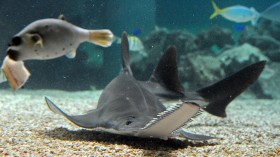There's a new discovery about Saturn's most intriguing moon, Enceladus. Researchers have revealed that there's a global ocean lying a few kilometers beneath its icy surface.
The study from Charles University in Prague and the Royal Observatory of Belgium published in the journal Geophysical Research Letters used data from NASA's Cassini spacecraft to create a new model that reconciles contradictory information about Encedalus, revealing that the moon's south pole may have an icy shell that's only a few kilometers thick. The particular thinness of the icy shell suggests that Encedalus' interior is hot, creating a possibility that an ocean may exist on its surface.
According to Science Daily, previous flybys of the Cassini Spacecraft estimated the thickness of the icy shell from 30 to 40 kilometers. However, in 2015, an oscillation in the moon's rotation showed a much thinner icy shell than estimated at around 20 kilometers.
The researchers' model shows that Enceladus is covered with an elastic icy shell and a rocky core of about 185 kilometers. The model also shows that the thickness of its elastic icy shell varies in location. In the moon's south pole, the ice is only 5 kilometers thick, and underneath it is an internal ocean that's approximately 45 kilometers deep. The said ocean makes up 40 percent of the moon's surface with a salt content that's similar to the oceans on Earth.
The newly created model further supports the idea that Enceladus produces strong heat from hydrothermal vents on the ocean floor. Complex organic molecules have also been detected in Enceladus' jets, which suggest the emergence of new life forms. Because of the thinness of ice and the conditions of the moon, future explorations will also be possible.
“I think it’s a very nice piece of work. On the one hand, you have the gravity and topography, and on the other hand you have the librations. They’re using both those pieces of data, which hasn’t been done before," Francis Nimmo, a planetary scientist at the University of California Santa Cruz, told the AGU Blogosphere.
© 2024 NatureWorldNews.com All rights reserved. Do not reproduce without permission.
![Severe Thunderstorm Alert: Tornadoes, Damaging Winds and Hail Possible from Upper Ohio Valley to Northeast US [NWS]](https://1471793142.rsc.cdn77.org/data/thumbs/full/70161/280/157/50/40/severe-thunderstorm-alert-tornadoes-damaging-winds-and-hail-possible-from-upper-ohio-valley-to-northeast-us-nws.jpg)




